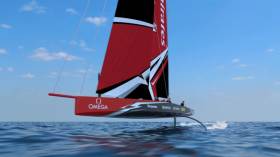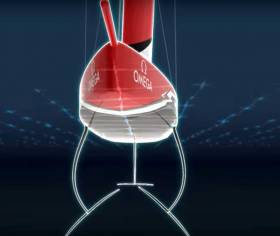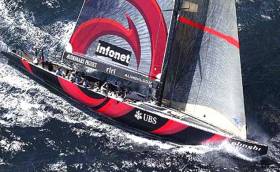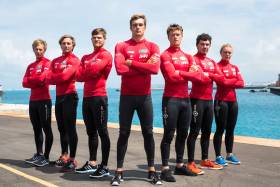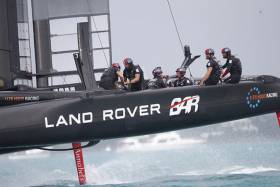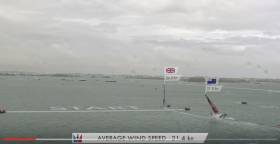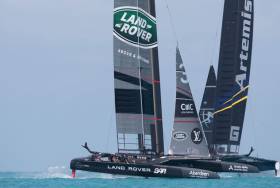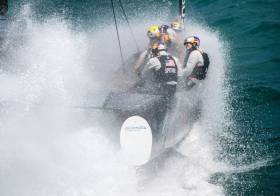Displaying items by tag: America's cup
There must be very few people in sailing who don’t know something of the America writes W M Nixon. She was the “low black schooner” which came across the Atlantic from New York in 1851, and won a race around the Isle of Wight for the One Hundred Pound Cup against the best that the Royal Yacht Squadron could muster.
The trophy in time became known as the America’s Cup, and thus was inaugurated what we’re told is the world’s longest-established international sporting challenge. Currently held by New Zealand, it has become a Holy Grail of top end sport, raced for by sailing machines at the most advanced (and expensive) level of technology. Yet such is the mystique of the boat which gave the trophy its name that the original America survived until 1945, and today replicas of the 139ft vessel still sail the sea.
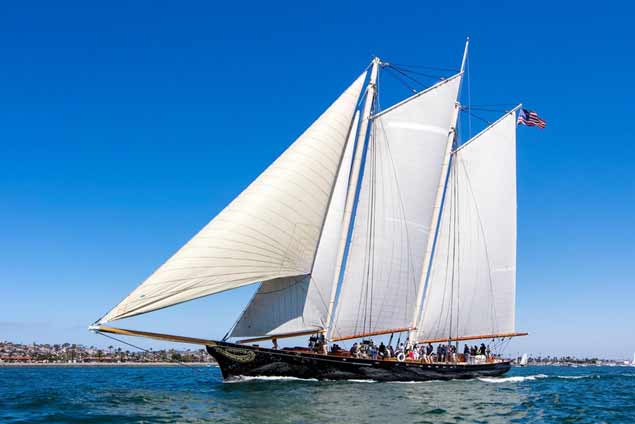 The original rig may have been modified for ease of handling, but America’s hull sails as sweet as ever
The original rig may have been modified for ease of handling, but America’s hull sails as sweet as ever
One of the best-known is in San Diego in California as a living seagoing display at the Maritime Museum. Her presence celebrates the fact that in 1987 the city’s favourite sailing son, Dennis Conner, returned to San Diego with the America’s Cup. The Australians had won it in 1983 from the previously impregnable American retention of 132 years, but the Californian skipper duly took the silver cup back from Australia in 1987, and put San Diego even more firmly on the global sailing map.
Recently, we were exchanging emails with Johnny Smullen, formerly of the National YC but now of San Diego, where his brilliant detail-work boat-building skills have long been associated with Dennis Conner’s remarkable collection of classic yachts. The reason for our email exchange was the success of Bill Trafford of Alchemy Marine in County Cork in winning the of Classic Boat “Spirit of Tradition” award for the extraordinary re-working he did in transforming a very ordinary and rather tired Etchells 22 into the head-turning and immaculately dark blue weekend cruiser Guapa.
This is a project that Johnny is much taken with, and in cheerily signing off, he mentioned that next day, he and the crew of his own beautiful classic Altair - an International One Design - would be transferring their skills aboard the schooner America for the 29th Annual America’s Schooner Race, a noted feature of the San Diego sailing calendar.
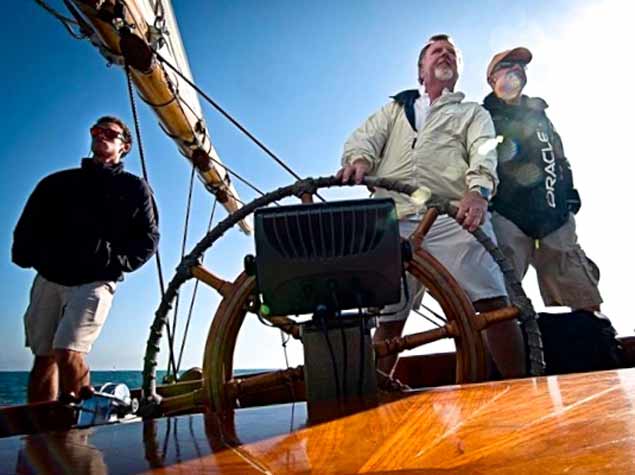 Johnny Smullen of the National YC on America’s helm in San Diego
Johnny Smullen of the National YC on America’s helm in San Diego
While they may not be able to muster the considerable schooner numbers of the glory days of the rig, the presence of the low black schooner America as a competitor is enough to be going along with, while anyone with the smallest drop of sailing blood will be fascinated to know how the America handles, and particularly what she’s like to steer.
For in her day, before new owners (who included two Anglo-Irish landowners) started to change her, America was renowned for her simplicity of rig and lightness on the helm. In fact, it’s said that at one stage she was tiller-steered, and the tiller required was no longer than a broom handle. As for her original rig, it was quintessential mid-19th Century American, with well-raked masts of much the same modest height, a single jib on a boom, and a boomless gaff foresail which overlapped the large mainsail to provide added slot effect. And that was basically it – a topsail above the mainsail appears to have been only there as a light weather sail.
"America was renowned for her simplicity of rig and lightness on the helm"
Under this rig, she had come across the Atlantic with impressive ease. And as for racing, the clockwise circuit of the Isle of Wight may have included only 15 miles of direct beating off the southeast coast of the island, but over those 15 miles the supposedly un-weatherly schooner put more than seven miles between herself and the next yacht, a cutter.
She was simplicity itself, and not unduly cluttered with luxury accommodation, so inevitably her successors – which have corporate entertainment with its necessary comforts ranked high on their programmes – tend to be heavier. And they may have a more easily handled rig, for the original three basic sails were enormous.
 The sweetest lines afloat – thanks to having a vertical rudder and a balanced shape, America is good to sail and steer
The sweetest lines afloat – thanks to having a vertical rudder and a balanced shape, America is good to sail and steer
Nevertheless the spirit lives on, and when we look at her lines we see why she is light on the helm – her rudder is vertical for maximum effectiveness, and though she won’t spin like a top, she is very manageable to steer - as Johnny Smullen tells us, she is really nice to sail, even if the tiller is replaced by a wheel.
But while San Diego’s America always causes a flutter when she puts to sea, the main story in this year’s sailing of the 29th Annual America’s Schooner Race in San Diego was that the winner was the same schooner which won the event at its inauguration nearly 30 years ago, and she’s still being sailed by the same owner and his family.
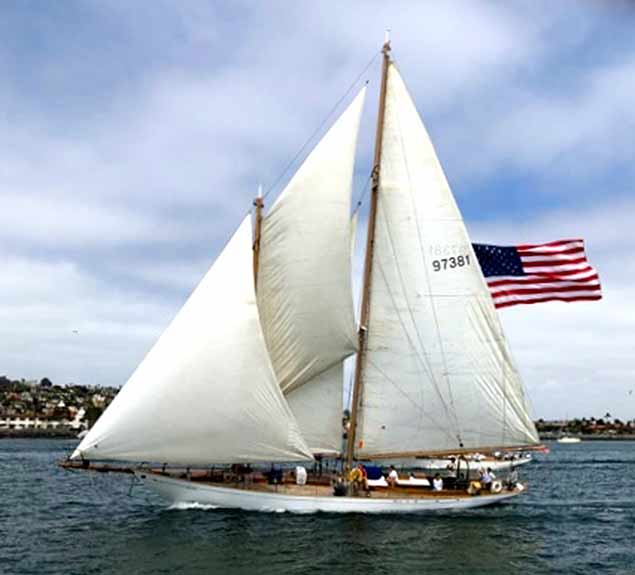 Paul Plott’s 1930-built Alden 61ft schooner Dauntless won the first America’s Schooner Race thirty years ago, and did so again this year. Photo: Johnny Smullen
Paul Plott’s 1930-built Alden 61ft schooner Dauntless won the first America’s Schooner Race thirty years ago, and did so again this year. Photo: Johnny Smullen
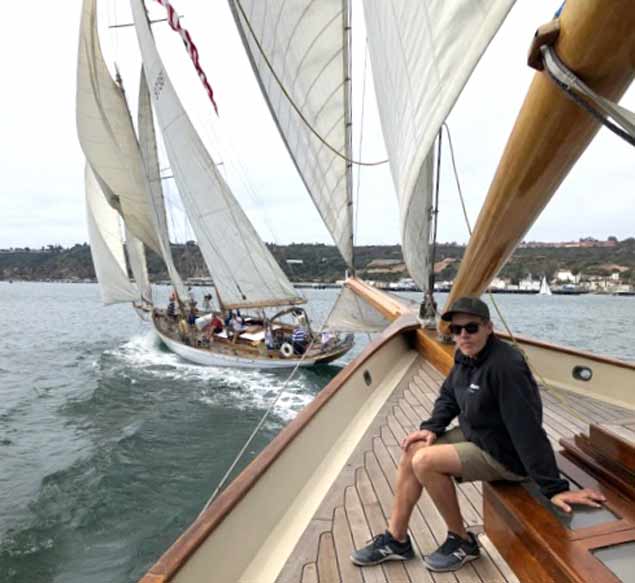 In the light breezes, Dauntless’s huge spread of sail enabled her to nip in ahead of America
In the light breezes, Dauntless’s huge spread of sail enabled her to nip in ahead of America
The 61ft schooner Dauntless is classic John Alden type, built in 1930 with her lines evolved from the great fishing schooners of the Grand Banks. She sets an enormous spread of sail, so in the lightish winds for this year’s race, she was in her element and her owner Paul Plotts was a very popular winner.
But then, at age 91 and with well over thirty years of caring for the often-successfully-raced Dauntless, Paul Plotts is somebody very special. The schooner America can’t have minded being bested by this remarkable combination of boat and skipper.
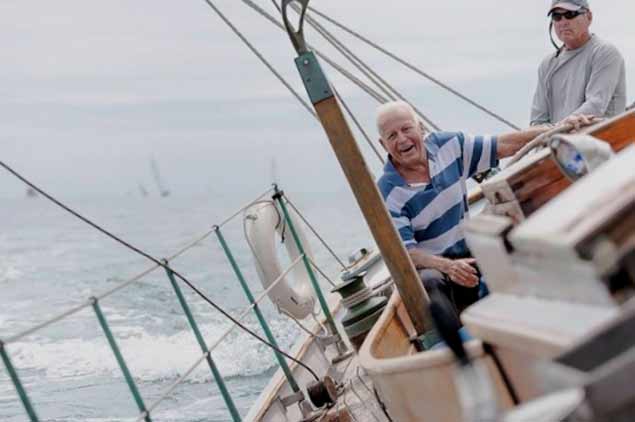 Paul Plotts in great form as he wins with Dauntless nicely in time for his 91st birthday
Paul Plotts in great form as he wins with Dauntless nicely in time for his 91st birthday
With Foiling Increasing Where is Sailing Going?
Welcome to my weekly podcast…. That question – where is sailing going? - has been in my mind since Emirates Team New Zealand media information came to me this week about the yacht they intend to race at the next Americas Cup in 2021.
With foiling increasing, it makes me wonder where and what the sport will be like when the youngsters preparing this week for sailing’s primary talent-spotting competition next week in Dun Laoghaire – the Youth Sailing Pathway Championships – reach mature sailing age.
I’ve never seen anything like this new boat. Most sailors won’t have.
The Kiwis have described it as “a flying monohull….” and Afloat.ie reported previously on it here.
A boatbuilding acquaintance said: “I hope it’s made from strong stuff otherwise it will be like flying a plane with a wing missing,”
Instead of a keel, it has two canting, ballasted T-foils, will tack and gybe on the foils and be self-righting in the event of a capsize, the Kiwis say.
It has taken the only other fully-funded and confirmed team for 2021, Ben Ainslie’s British Land Rover BAR, by surprise, but they’ve described it as “a good call in the spirit of the Cup.”
The Kiwis maintain that they have kept faith with their stated intention to move the Cup back from catamarans to monohulls, bringing together the best features of multlhull high speed with traditional monohull sailing, to be raced by a crew of 12.The challenger of record, Luna Rossa, has partnered in the design which, according to ETNZ “promises to open up another immense new chapter in foil development and sailing technique.”
Grant Dalton, New Zealand Team CEO says the Cup in Auckland in 2021will be an exciting place….
That seems very likely….listen to the podcast below:
America's Cup New Yacht Design: Fully Foiling AC75 Yacht Revealed (VIDEO)
An exciting new era in America's Cup racing has been unveiled today as the concept for the AC75, the class of boat to be sailed in the 36th America's Cup is released illustrating a bold and modern vision for high performance fully foiling monohull racing yachts.
The Emirates Team New Zealand and Luna Rossa design teams have spent the last four months evaluating a wide range of monohull concepts. Their goals have been to design a class that will be challenging and demanding to sail, rewarding the top level of skill for the crews; this concept could become the future of racing and even cruising monohulls beyond the America's Cup.
The AC75 combines extremely high-performance sailing and great match racing with the safety of a boat that can right itself in the event of a capsize. The ground-breaking concept is achieved through the use of twin canting T-foils, ballasted to provide righting-moment when sailing, and roll stability at low speed.
The normal sailing mode sees the leeward foil lowered to provide lift and enable foiling, with the windward foil raised out of the water to maximise the lever-arm of the ballast and reduce drag. In pre-starts and through manoeuvres, both foils can be lowered to provide extra lift and roll control, also useful in rougher sea conditions and providing a wider window for racing.
Although racing performance has been the cornerstone of the design, consideration has had to be focused on the more practical aspects of the boat in the shed and at the dock, where both foils are canted right under the hull in order to provide natural roll stability and to allow the yacht to fit into a standard marina berth.
An underlying principle has been to provide affordable and sustainable technology 'trickle down' to other sailing classes and yachts. Whilst recent America's Cup multihulls have benefitted from the power and control of rigid wing sails, there has been no transfer of this technology to the rigs of other sailing classes. In tandem with the innovations of the foiling system, Emirates Team New Zealand and Luna Rossa are investigating a number of possible innovations for the AC75's rig, with the requirement that the rig need not be craned in and out each day. This research work is ongoing as different concepts are evaluated, and details will be released with the AC75 Class Rule before March 31st, 2018.
The America's Cup is a match race and creating a class that will provide challenging match racing has been the goal from the start. The AC75 will foil-tack and foil-gybe with only small manoeuvring losses, and given the speed and the ease at which the boats can turn the classic pre-starts of the America's Cup are set to make an exciting comeback. Sail handling will also become important, with cross-overs to code zero sails in light wind conditions.
A huge number of ideas have been considered in the quest to define a class that will be extremely exciting to sail and provide great match racing, but the final decision was an easy one: the concept being announced was a clear winner, and both teams are eager to be introducing the AC75 for the 36th America's Cup in 2021.
The AC75 class rule will be published by March 31st 2018
America’s Cup Goes Back to Monohulls & Dublin Bay Water Wags Were First to Know
It has been confirmed that the next edition of the America’s Cup will see defenders New Zealand organise the racing in monohulls, after three stagings of the world’s oldest international sporting challenge in multihulls writes W M Nixon.
This will come as no surprise to those who were at the extraordinary Dun Laoghaire gathering twelve days ago when the 130-year Dublin Bay Water Wags celebrated their first race with more than thirty boats.
They partied in the Royal Irish Yacht Club with the crew and supporters of the Alex Thomson/Nin O’Leary IMOCA 60 Hugo Boss. It was a busy multi-agenda night, with the air well filled with stories old and new.
But as reported in Sailing on Saturday on September 2nd, one noted Dublin-based heavy hitter in the international sailing scene at the party was able to disclose that, with the support of top European America’s Cup interests, the America’s Cup next time round - in which Italian team Luna Rossa are the Challengers of Record – will be raced in monohulls.
The word was that they’d be skinny 73ft hulls with enormous keels, aboard which sailors will be seen to be people rather than robots. And it seems it’s all happening. But with the Mini Transat, the Volvo World Race, and the Rolex Middle Sea Race starting to come up the programme listings, there’s time enough before anyone starts losing any sleep over the next America’s Cup...
BAR Academy Squad for Youth America's Cup
The long months of preparation are almost at an end as seven of Britain's most talented and ambitious young sailors take on the world. The hand-picked team, including Neil Hunter, 22 year old from Scotland, who raced with Ben Ainslie in Land Rover BAR's America's Cup bid, will represent Britain in the Red Bull Youth America's Cup (RBYAC) starting on Monday 12th June on Bermuda's Great Sound.
They will step out onto the main stage – the same course used for the America's Cup racing currently underway in Bermuda – for two days of racing against five other youth teams, all comprising of sailors aged 19-24. The top four teams will go forward to the finals, scheduled right before the last weekend of racing for the 35th America's Cup.
The teams will race the foiling, wingsail AC45F used throughout the Louis Vuitton America's Cup World Series 2015 and 2016, and the Land Rover BAR Academy have looked strong in the practice racing so far. They continue to benefit from the mentorship and experience of the senior team, who completed their campaign for the 35th America's Cup on Thursday.
Inspired by four time Olympic gold medallist and 34th America's Cup winner, Ben Ainslie, the mission of the Land Rover BAR Academy is to find and support talented young British sailors. It's run by America's Cup Challenger Land Rover BAR, and supported by Land Rover.
The goal is to create a career pathway for British sailors into the America's Cup, and build a British team to win the RBYAC. The Land Rover BAR Academy have already competed in the 2016 Extreme Sailing Series™, coming fifth in the professional stadium racing series, supported and mentored by the Land Rover BAR Senior Sailing team.
The spectacular sailing on Bermuda's Great Sound promises to be a wonderful showcase for these talented young sailors and a great inspiration to those that want to follow them.
Rob Bunce, Land Rover BAR Academy Skipper: "We're looking forward to getting on the start line, it's going to be really exciting racing. It will be really cool on that first real race with all those boats - it's going to be epic!
"At the moment we are expecting the conditions to be a mixture of light and strong winds. We enjoy the breeze more than the light winds, but the conditions in Bermuda change so quickly, anything could happen.
"The Red Bull Youth America's Cup differs to the Extreme Sailing Series in that the course will be bigger, the boats are bigger and faster and a bit harder to sail I think there will be more of a boat handling focus and that's an area that we pride ourselves on. It's also going to be important to get off the start line well, just like the ESS."
Annabel Vose, Strategist: "It's a really cool opportunity to race on the same race course as the America's Cup and be a part of that atmosphere. It's going be really exciting having eight boats on the race course, which is more than any America's Cup World Series event so it's going to be really intense and a great spectacle as we hopefully reach some high speeds. It's definitely a new challenge for all of us; no-one has raced in these boats before so we're looking forward to getting stuck in on Monday."
Youth America's Cup Squad:
Skipper, Rob Bunce - Southampton
Helm, Chris Taylor - Buckinghamshire
Strategist, Annabel Vose - Southampton
Main Trimmer, Elliot Hanson - Macclesfield
Jib Trimmer, Sam Batten - Southampton
Jib Trimmer / Float, Adam Kay - Southampton
Bow, Neil Hunter - Isle of Arran, Scotland
Dates for the diary:
May 29th – June 3rd 2017: Pool A team training
June 5th – June 10th : Pool B team training
June 12th – June 13th : Qualifier 1 racing *
June 15th - June 16th : Qualifier 2 racing *
June 20th – June 21st : Red Bull Youth America's Cup Final Series *
* all race events include a third day of scheduled racing, held in reserve should any issues prevent racing being completed on scheduled dates
The Bell Tolls For Ainslie
Sir Ben Ainslie and Land Rover BAR's quest to win the 35th America's Cup came to an early end on Thursday in Bermuda when Peter Burling and Emirates Team New Zealand sealed the British team's fate by reaching the five wins needed against Land Rover BAR to progress to the Louis Vuitton America's Cup Challenger Playoffs Finals.
In the other Semi-Finals, Nathan Outteridge and Artemis Racing mounted an almighty comeback against their Japanese rivals, Dean Barker's SoftBank Team Japan, winning three races on the trot to take the score in their Louis Vuitton America's Cup Challenger Playoffs Semi-Finals to 4-3, meaning they will race again on Friday to decide the second Finalist.
For Ainslie and his team, they were ultimately beaten by Emirates Team New Zealand twice on Thursday, sealing their fate 5-2 and leaving them heading back to Britain without the America's Cup they were so determined to take home.
For Burling and his crew, the incredible efforts the team made from Tuesday to Thursday to repair the boat that was so badly damaged in Tuesday's pitchpole were repaid handsomely, putting themselves into the Louis Vuitton America's Cup Challenger Playoffs Finals as the first team to reach that stage.
Turning his attention to the potential opponent in the Louis Vuitton America's Cup Challenger Playoffs Final, Burling admitted he does not have a preference between Artemis Racing or SoftBank Team Japan.
In stark contrast to Tuesday's poor performance, Nathan Outteridge and his team looked assured throughout the race, maintaining a slender lead over the pursuing SoftBank Team Japan.
While Dean Barker sailed an almost faultless race, Artemis Racing did not make the mistake the Japanese team would have been hoping for and Nathan Outteridge steered his team home with a 28 second victory, levelling the scores at 3-3 ahead of the teams' third and final battle of the day.
Race results
Semi-Final 1 Race 5: Emirates Team New Zealand beat Land Rover BAR by 31 seconds
Semi-Final 1 Race 5: Artemis Racing beat SoftBank Team Japan by 39 seconds
Semi-Final 1 Race 6: Land Rover BAR beat Emirates Team New Zealand 20 seconds
Semi-Final 1 Race 6: Artemis Racing beat SoftBank Team Japan by 28 seconds
Semi-Final 1 Race 7: Emirates Team New Zealand beat Land Rover BAR by 46 seconds
Semi-Final 1 Race 7:Artemis Racing beat SoftBank Team Japan by 1 minute and 46 seconds
A Big Day At The America's Cup Bermuda (VIDEO)
An epic day of racing unfolded on the Great Sound in Bermuda for the Louis Vuitton America's Cup Playoff Semi-finals as Land Rover BAR faced off against Emirates Team New Zealand. The first race got underway after a slight delay waiting for the wind to drop below the 24 knots average limit. Emirates Team New Zealand only just made the start after damage sustained to their wing after docking out. It was panning out to be a full on day with both teams sailing at the limits hitting speeds in excess of 45 knots.
The British team won the start and led Emirates Team New Zealand for five of the nine leg race, before getting low on oil which enabled Emirates Team New Zealand to take the lead, as Sailing Team Manager Jono Macbeth explained:
"These boats are so physical up until now we have been racing a five or six leg course, today was a nine legger. It is unbelieveable how much energy is required to get around these courses, unfortunately for us we got low on oil at a critical time, so our manouvres weren't as crisp as they have could been".
In the second race Ben Ainslie and his British team again won the start, before Emirates Team New Zealand suffered a dramatic capsize on the first reach, with the race subsequently being awarded to Land Rover BAR.
Ben Ainslie, Skipper and Team Principal: "The most important thing is that everyone is okay on Emirates Team New Zealand after their capsize. I think all four teams out there showed great seamanship to deal with these boats in these conditions. It was absolutely full on. We look forward to seeing them back on the race course."
"It was unbelievable racing in gusts up to 27-28 knots. Certainly, in thirty years of racing boats, it was the most full-on, exhilarating moment I've ever had. It was incredible out there.
"I liken it to skiing on ice. No holds barred; if you start to slow up and play it safe that's when it is worse. When you sail these boats fast it is very rewarding, but in conditions like today sometimes it is not possible. Days like today it is the ultimate team sport."
"Hopefully we will be back out on the water tomorrow and it's all to play for."
The current forecast for tomorrow is predicting stronger winds than today. The team are getting ready for another epic day of racing.
Current scoreboard
Semi Final 1
Land Rover BAR - 1
Emirates Team New Zealand - 3
Semi Final 2
Softbank Team Japan - 3
Artemis Racing - 1
Wednesday's schedule:
Race 5: NZ vs GBR
Race 5: Sweden vs Japan
Race 6: GBR vs NZ
Race 6: Japan vs Sweden
The semi-finals are first - to - five.
Ben Ainslie Wins Against Artemis Racing in Robin Robin 2 of the America's Cup Qualifiers
There was to be no redemption for Artemis Racing at the start of the Louis Vuitton America’s Cup Qualifiers Round Robin 2 stage, as they fell to a second defeat in as many days to Emirates Team New Zealand.
Yesterday, in what was the the most thrilling and contentious day of racing in the 35th America’s Cup so far, the Swedish team were denied a victory over their Kiwi rivals following a dramatic late penalty in the final race of the day in Round Robin 1.
Picking up where the competition left off, day four started with a mouth-watering rematch between the two nations as the Swedish team looked for revenge for their loss in Round Robin 1.
The Swedes looked odds on to achieve just that in the early stages of the race as they led from the start, building up a 20 seconds lead following a big nosedive from Emirates Team New Zealand in the lead up to gate 2.
However, the Kiwis, helmed by Peter Burling, recovered spectacularly from the set-back, chasing down the Swede and cutting their lead to just three seconds at gate 3 before wiping out the lead altogether at gate 5.
As the teams crossed paths in close proximity heading into the gate, it was Emirates Team New Zealand who emerged in front as they headed for the final turn before the race for the finish line.
With Artemis Racing in hot pursuit, they were handed a late penalty, forcing them to fall further behind their rivals and all but ending the contest. From that point, Emirates Team New Zealand coasted to the finish line and won by one minute and 31 seconds over the Swedish team.
The triumph saw Emirates Team New Zealand secure their fifth victory out of six races in the qualifying stages, equalling ORACLE TEAM USA’s point tally in the standings ahead of the American team’s race against Groupama Team France in race 2.
However, the Kiwis were not level in the standings for long, as Jimmy Spithill’s ORACLE TEAM USA restored their point advantage with a comfortable and impressive victory over Franck Cammas’ team.
Having successfully hooked the French boat in the pre-start and crossing the start line seven seconds in front, ORACLE TEAM USA set about building their lead in the early stages of the race.
Groupama Team France’s task was made even harder following a penalty for crossing the boundary mark on leg two, forcing them even further behind the American team who raced well clear.
However, the Americans did not have it all their own way. Late in the race Tactician Tom Slingsby reported over the team radio that “We have an issue”, leading to Kyle Langford having to make running repairs to their boat’s wingsail on leg five.
However, despite the issue, ORACLE TEAM USA continued to sail smoothly, meaning there was to be no late drama or shock and the Defenders of the ‘Auld Mug’ finished the race one minute and 56 seconds ahead of their opponents.
Meanwhile, Land Rover BAR secured a much needed victory in the final race of the afternoon (race 3) as they overcame Artemis Racing with a 30 second advantage at the finish line.
Having won just one race in the Louis Vuitton America’s Cup Qualifiers Robin 1, also over Artemis Racing, the pressure was on Sir Ben Ainslie and his team heading into the encounter.
However, that pressure was not evident out on the water as the British team made a better start than their Swedish rivals, who were also racing for the second time on the day.
In a much improved performance over the previous two days, Land Rover BAR, who hit the highest speed of the competition so far, recording a top speed just over 43 knots, maintained a comfortable advantage throughout the race as they kept the Swedes at bay.
Despite a slight touch down by the British team at mark 4, they recovered quickly to ease over the finish line 30 seconds ahead of Nathan Outteridge’s team to seal a much needed victory. That win moves Land Rover BAR onto four points in the standings, and more importantly, two points clear of bottom-placed Groupama team France.
The first day of racing at the Louis Vuitton America's Cup Qualifiers started with extraordinary drama as Land Rover BAR defied all the sceptics and the pundits that had written the team off. They beat the pre-regatta in-form boat, Sweden's Artemis Racing in the opening contest. It was a wire-to-wire victory for the British challenger, with the lead yo-yoing from ten to twenty seconds, but Land Rover BAR were never threatened after taking control at Mark One.
No sooner had the adrenaline ebbed, then the team were back into the fray with a race against SoftBank Japan. On the final line-up towards the start line, SoftBank Team Japan's skipper, Dean Barker moved into an overlapping position on the leeward side of Land Rover BAR, a move that resulted in a dramatic clash as the two boats came together, the hull of Land Rover BAR being punctured by the pedestal on the Japanese team. The penalty went against Land Rover BAR, who continued racing nursing the damaged boat around the course, with SoftBank Team Japan taking the win. The foiling conditions helped keep Land Rover BAR afloat, at the end of the race the team foiled into Bermuda's Historic Dockyard to a waiting crane, with the whole team furiously bailing to keep R1 afloat.
A long night now awaits the shore team to try and fix the damage and get back onto the race course for the second day of racing in the Qualifying round of the 35th America's Cup.
At the end of the first day's racing, Land Rover BAR are joint leaders with Oracle Team USA on three points, with Artemis Racing, Emirates Team New Zealand and SoftBank Team Japan all on one point.
Team work saved R1 from sinking after collision with SoftBank Team Japan
Thoughts on the racing:
Ben Ainslie, Skipper and Team Principal: "The boat is pretty badly damaged, with a sizeable hole in the port hull. It was a great effort by the team to get the boat around the course in the state that it was in. We were better off foiling with the hull out of the water, and we tried to keep the boat on the foils right into the harbor.
"We were lucky we did, by the time we got to the dock she was on her way down. It was all hands to the pumps and bailing. It's been about 30 years since I was bailing out Optimist dinghies, and it wasn't something I was expecting to do.
"The collision was unfortunate, we had a sideways slip just as Dean came in and got the leeward overlap. No one wants that, certainly in our position as we picked up a penalty and the damage. Thankfully, the most important thing is that no one got hurt.
"It's now down to the shore team to work their magic and fix the damage and try to get us back out for racing tomorrow. They are great guys, they've got us through some pretty rough patches in the past and hopefully they can do it again.
"With regards to the rest of the day, we had a fantastic race against Artemis Racing. Going into this competition, I think a lot of seasoned observers had written us off, saying that we didn't have a chance. We came out today when it counts and beat a really, really good team. So I can be proud of our team, and where we have come from and the potential we have to move forwards, this is hugely positive for the team."
Richy O'Farrell, Shore Team Lead: "We had a coming together with Japan in the pre-start, it looks like we had a bit of a side-slip and landed on top of them. So they punctured our hull from underneath, and we have done quite a lot of damage to the hull. Over the next hour or so we'll make a plan as to what we are going to do to fix it, and see how long it is going to take us. It's quite a lot of damage. A long night ahead, I'd say.
America's Cup Day One Scrubbed Due to Strong Winds
The America’s Cup Event Authority (ACEA), and America’s Cup Race Management (ACRM), have announced that the strong winds in Bermuda has meant day one of the Louis Vuitton America’s Cup Qualifiers and the Official Opening Ceremony of the 35th America’s Cup has had to be postponed.
Forecasts indicate that winds may gust over 30 knots during the afternoon and evening, so with the safety of the sailors and spectators as the key priority, ACEA and ACRM have decided to postpone Friday’s events. Saturday 27th May and the days following are all forecast to have significantly improved weather conditions, so the four races scheduled to take place on Friday 26th May will now be added to the race schedules for the subsequent days.
The Official Opening Ceremony of the 35th America’s Cup will now take place on Saturday 27th May, starting at 8.30pm, following the three time Grammy award winning entertainer Wyclef Jean’s performance on the Main Stage in the America’s Cup Village at 5.15pm. The America’s Cup Village will close at 9.30pm. Gates open at 11.30am on Saturday, with racing due to take place between 2pm and 5pm.
Sir Russell Coutts, CEO of the ACEA, said, “We are obviously disappointed that the strong winds mean we have had to postpone day one of the 35th America’s Cup. This is clearly a decision we have not taken lightly and appreciate the inconvenience caused to the sellout crowd. Our primary concern however, is always safety for everyone involved in the America’s Cup. We are adding an hour to the race window on both Saturday and Sunday to run extra races with the aim of getting back on schedule. There are still tickets available at the weekend, although not in all categories, so we are hoping Friday’s ticket holders will still get the chance to enjoy what should be an incredible opening weekend.”




























